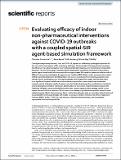Evaluating efficacy of indoor non-pharmaceutical interventions against COVID-19 outbreaks with a coupled spatial-SIR agent-based simulation framework
Author(s)
Gunaratne, Chathika; Reyes, Rene; Hemberg, Erik; O’Reilly, Una-May
Downloads41598-022-09942-y.pdf (2.509Mb)
Publisher with Creative Commons License
Publisher with Creative Commons License
Creative Commons Attribution
Terms of use
Metadata
Show full item recordAbstract
<jats:title>Abstract</jats:title><jats:p>Contagious respiratory diseases, such as COVID-19, depend on sufficiently prolonged exposures for the successful transmission of the underlying pathogen. It is important that organizations evaluate the efficacy of non-pharmaceutical interventions aimed at mitigating viral transmission among their personnel. We have developed a operational risk assessment simulation framework that couples a spatial agent-based model of movement with an agent-based SIR model to assess the relative risks of different intervention strategies. By applying our model on MIT’s Stata center, we assess the impacts of three possible dimensions of intervention: one-way vs unrestricted movement, population size allowed onsite, and frequency of leaving designated work location for breaks. We find that there is no significant impact made by one-way movement restrictions over unrestricted movement. Instead, we find that reducing the frequency at which individuals leave their workstations combined with lowering the number of individuals admitted below the current recommendations lowers the likelihood of highly connected individuals within the contact networks that emerge, which in turn lowers the overall risk of infection. We discover three classes of possible interventions based on their epidemiological effects. By assuming a direct relationship between data on secondary attack rates and transmissibility in the agent-based SIR model, we compare relative infection risk of four respiratory illnesses, MERS, SARS, COVID-19, and Measles, within the simulated area, and recommend appropriate intervention guidelines.</jats:p>
Date issued
2022-04-13Department
Massachusetts Institute of Technology. Computer Science and Artificial Intelligence LaboratoryPublisher
Springer Science and Business Media LLC
Citation
Gunaratne, Chathika, Reyes, Rene, Hemberg, Erik and O’Reilly, Una-May. 2022. "Evaluating efficacy of indoor non-pharmaceutical interventions against COVID-19 outbreaks with a coupled spatial-SIR agent-based simulation framework." 12 (1).
ISSN
2045-2322